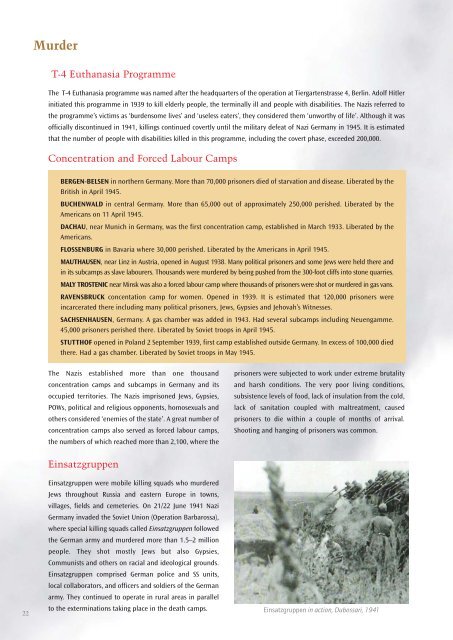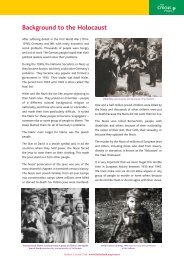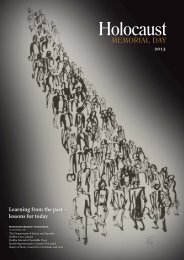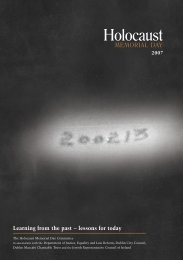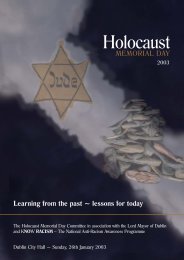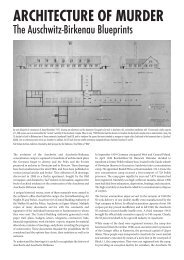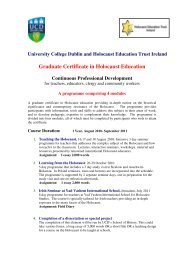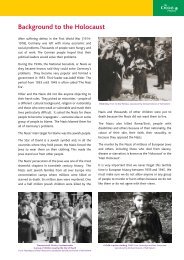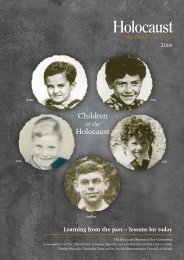Learning from the past ~ lessons for today - Holocaust Education ...
Learning from the past ~ lessons for today - Holocaust Education ...
Learning from the past ~ lessons for today - Holocaust Education ...
You also want an ePaper? Increase the reach of your titles
YUMPU automatically turns print PDFs into web optimized ePapers that Google loves.
Murder<br />
T-4 Euthanasia Programme<br />
The T-4 Euthanasia programme was named after <strong>the</strong> headquarters of <strong>the</strong> operation at Tiergartenstrasse 4, Berlin. Adolf Hitler<br />
initiated this programme in 1939 to kill elderly people, <strong>the</strong> terminally ill and people with disabilities. The Nazis referred to<br />
<strong>the</strong> programme’s victims as ‘burdensome lives’ and ‘useless eaters’, <strong>the</strong>y considered <strong>the</strong>m ‘unworthy of life’. Although it was<br />
officially discontinued in 1941, killings continued covertly until <strong>the</strong> military defeat of Nazi Germany in 1945. It is estimated<br />
that <strong>the</strong> number of people with disabilities killed in this programme, including <strong>the</strong> covert phase, exceeded 200,000.<br />
Concentration and Forced Labour Camps<br />
BERGEN-BELSEN in nor<strong>the</strong>rn Germany. More than 70,000 prisoners died of starvation and disease. Liberated by <strong>the</strong><br />
British in April 1945.<br />
BUCHENWALD in central Germany. More than 65,000 out of approximately 250,000 perished. Liberated by <strong>the</strong><br />
Americans on 11 April 1945.<br />
DACHAU, near Munich in Germany, was <strong>the</strong> first concentration camp, established in March 1933. Liberated by <strong>the</strong><br />
Americans.<br />
FLOSSENBURG in Bavaria where 30,000 perished. Liberated by <strong>the</strong> Americans in April 1945.<br />
MAUTHAUSEN, near Linz in Austria, opened in August 1938. Many political prisoners and some Jews were held <strong>the</strong>re and<br />
in its subcamps as slave labourers. Thousands were murdered by being pushed <strong>from</strong> <strong>the</strong> 300-foot cliffs into stone quarries.<br />
MALY TROSTENIC near Minsk was also a <strong>for</strong>ced labour camp where thousands of prisoners were shot or murdered in gas vans.<br />
RAVENSBRUCK concentation camp <strong>for</strong> women. Opened in 1939. It is estimated that 120,000 prisoners were<br />
incarcerated <strong>the</strong>re including many political prisoners, Jews, Gypsies and Jehovah’s Witnesses.<br />
SACHSENHAUSEN, Germany. A gas chamber was added in 1943. Had several subcamps including Neuengamme.<br />
45,000 prisoners perished <strong>the</strong>re. Liberated by Soviet troops in April 1945.<br />
STUTTHOF opened in Poland 2 September 1939, first camp established outside Germany. In excess of 100,000 died<br />
<strong>the</strong>re. Had a gas chamber. Liberated by Soviet troops in May 1945.<br />
The Nazis established more than one thousand<br />
concentration camps and subcamps in Germany and its<br />
occupied territories. The Nazis imprisoned Jews, Gypsies,<br />
POWs, political and religious opponents, homosexuals and<br />
o<strong>the</strong>rs considered ‘enemies of <strong>the</strong> state’. A great number of<br />
concentration camps also served as <strong>for</strong>ced labour camps,<br />
<strong>the</strong> numbers of which reached more than 2,100, where <strong>the</strong><br />
prisoners were subjected to work under extreme brutality<br />
and harsh conditions. The very poor living conditions,<br />
subsistence levels of food, lack of insulation <strong>from</strong> <strong>the</strong> cold,<br />
lack of sanitation coupled with maltreatment, caused<br />
prisoners to die within a couple of months of arrival.<br />
Shooting and hanging of prisoners was common.<br />
22<br />
Einsatzgruppen<br />
Einsatzgruppen were mobile killing squads who murdered<br />
Jews throughout Russia and eastern Europe in towns,<br />
villages, fields and cemeteries. On 21/22 June 1941 Nazi<br />
Germany invaded <strong>the</strong> Soviet Union (Operation Barbarossa),<br />
where special killing squads called Einsatzgruppen followed<br />
<strong>the</strong> German army and murdered more than 1.5–2 million<br />
people. They shot mostly Jews but also Gypsies,<br />
Communists and o<strong>the</strong>rs on racial and ideological grounds.<br />
Einsatzgruppen comprised German police and SS units,<br />
local collaborators, and officers and soldiers of <strong>the</strong> German<br />
army. They continued to operate in rural areas in parallel<br />
to <strong>the</strong> exterminations taking place in <strong>the</strong> death camps.<br />
Einsatzgruppen in action, Dubossari, 1941


